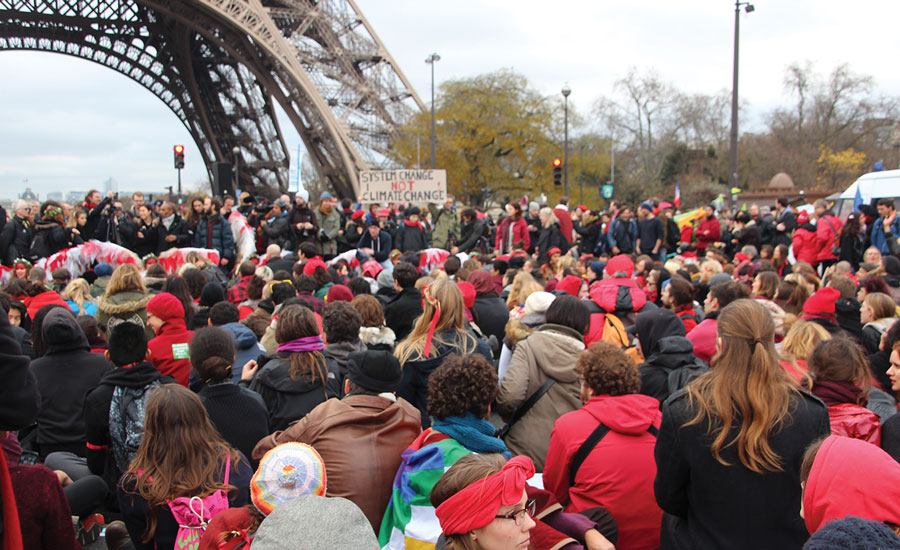The year 2015 was monumental for the environment.
In July, the U.S. Environmental Protection Agency (EPA) issued its Final Rule – Protection of Stratospheric Ozone, which changed the status of specific hydrofluorocarbons (HFCs) in certain applications and likely signaled the beginning of the end for HFCs as stand-alone refrigerants.
In November, the parties to the Montreal Protocol met in Dubai, United Arab Emirates, and agreed to complete an amendment in 2016 to reduce the global production and consumption of HFCs.
And, in mid-December, representatives from nearly 200 nations gathered in Paris and approved the first global pact to fight climate change by first reducing and then ultimately eliminating greenhouse gas (GHG) emissions.
The Paris Agreement established a mechanism to review national-level actions to address climate change and created a process of submitting and reviewing the national climate action plans, or Intended Nationally Determined Contributions (INDCs), on a regular basis.
However, it’s important to note that although the Paris Agreement sets forth national targets for reducing greenhouse gas emissions, it imposes no penalties for countries that miss their targets. The ultimate objective is to ensure global temperature rise stays well below 2°C.
“History will remember this day,” said Ban Ki Moon, U.N. secretary general. “The Paris agreement on climate change is a monumental success for the planet and its people.”
Gina McCarthy, EPA administrator, praised the Paris agreement as, “An historic moment, a time when the people of the world came together, turned the corner, and decided we would put words into action and embrace one of our greatest challenges, combating the threat of climate change.
“This agreement gives hope to families in the U.S. and around the world that we are doing everything we can to leave a safer and healthier world for our kids and future generations,” she added. “The EPA will work tirelessly to share our expertise in defense of public health and the environment as we work together to implement this agreement.”
McCarthy also called on businesses to “think creatively and seize this opportunity to lead the world in developing a clean-energy economy.”
However, not everyone was so effusive in their praise of the Paris agreement.
“When I look at what happened in Paris, I see a lot of flash and spin, but absolutely no substance,” said Gordon McKinney, vice president and COO of Icor Intl. “I see us depending upon two huge consumers of refrigerants and emitters of CO2, India and China, both of which continue to build coal-fired plants. I don’t think they’re going to meet any of their goals, and I don’t think anything that was said [in Paris] carries any weight whatsoever.”
McKinney also expressed his misgivings about the HFC phaseout, noting that, thanks to good manufacturing techniques and materials, and what he cited as the underrated contributions of aftermarket leak-stop agents and additives, air conditioning and refrigeration systems are tighter and more leak-free than ever before.
“I know leak-stop additives are not endorsed by OEMs, but they’ve proven themselves as highly effective and efficient,” McKinney said. “They’re not degrading system performance or causing system failures, and, over the past five to 10 years, they’ve helped keep vast amounts of refrigerants inside systems. The industry’s low leakage rates are just one more reason we should take a step back and ask if we really want to get rid of a whole generation of highly reliable, effective, proven refrigerants, such as the HFCs.”
AN 80 PERCENT REDUCTION
At the COP21 meeting in Paris, Kevin Fay, executive director for the Alliance for Responsible Atmospheric Policy, made a statement on behalf of the alliance’s member companies, stating, “I’m pleased to report on our progress to achieve our commitment to take actions and support policies to achieve an 80 percent reduction of HFC emissions by 2050.”
Fay noted the alliance has made significant progress in its two private-sector initiatives, the Global Food Cold Chain Council (GFCCC) and the Global Refrigerant Management Initiative.
“We’re confident that with an HFC amendment and actions under private sector-led initiatives, these actions could achieve up to a 100-gigaton reduction of carbon-equivalent emissions by 2050,” he said. “Most importantly, alliance member companies are investing billions of dollars in the research, development, and implementation of low-GWP compounds and technologies and are working closely with industry colleagues and governments around the world to further technological challenges, opportunities, and related policy issues,” Fay added.
He also cited a study that found an expansion of the food cold chain in developing countries could dramatically reduce net food waste greenhouse gas emissions.
“In a study by the Deloitte firm, we identified an additional annual savings of 180 million to 550 million tons of carbon dioxide equivalent if we were to simply expand the use of the cold chain in developing nations, thereby reducing food loss and waste,” Fay said. “This is the equivalent to the annual emissions of the country of France.”
CONGRESS TIGHTENS ITS PURSE STRINGS
Looking forward, the path is not entirely smooth for the Obama administration as it seeks to continue to advance its strong environmental agenda. For example, two weeks prior to the start of the Paris meeting, 37 Republican senators sent a letter to the president reminding him that any agreement with binding timetables and targets must be brought before Congress for approval.
“We support international dialogue on global environmental problems,” the senators wrote. “We do, however, have serious concerns about the impact any deal reached in Paris will have on the American economy and our international priorities.
“Your administration agreed to help raise $100 billion annually in funding for developing nations as part of the Green Climate Fund. The target for the Paris conference was to raise an initial $10 billion. You have unilaterally pledged $3 billion in U.S. taxpayer funds to the Green Climate Fund without the consent of Congress. Congress has never authorized funding for the Green Climate Fund. While the executive branch and Congress both play an important role in the foreign policy of our nation, Congress ultimately holds the power of the purse. We pledge that Congress will not allow U.S. taxpayer funds to go to the Green Climate Fund until the forthcoming international climate agreement is submitted to the Senate for its constitutional advice and consent.”
The senators added a request that Todd Stern, the U.S. special envoy to the talks, be forthcoming with his foreign counterparts.
“He must provide these nations with a full picture of where a co-equal U.S. branch of government stands on these issues,” they concluded. “He must explain that Congress will not be forthcoming with these funds in the future without a vote in the Senate on any final agreement as required in the U.S. Constitution.”
Despite the warning from the Republican senators, the Associated Press reported that the Paris agreement contains two subtle, but key, items that could allow the Obama administration to sign on without going through Congress. First, in a wording change from the draft agreement, the word “should” replaced the word “shall” when referring to developed countries committing to reduce their emissions. Second, the agreement states that it does not involve or provide any basis for any liability or compensation for losses that may occur from disasters related to climate change.
SIDEBAR: The American Business Act on Climate Pledge
More than 150 U.S. companies have signed the White House-led American Business Act on Climate Pledge, which was created in July 2015. Companies making the pledge have set significant greenhouse gas reduction and renewable energy sourcing goals for 2020 and beyond and are focusing on increasing energy efficiency, boosting low-carbon investing, and making sustainability more accessible to low-income Americans.
By signing the American Business Act on Climate Pledge, companies are demonstrating an ongoing commitment to climate action. As part of this initiative, each company is announcing significant pledges to reduce their emissions, increase low-carbon investments, deploy more clean energy, and take other actions to build more sustainable businesses and tackle climate change. These pledges include ambitious company-specific goals.
According to the White House, the companies have operations in all 50 states, employ nearly 11 million people, represent more than $4.2 trillion in annual revenue, and have a combined market capitalization in excess of $7 trillion.
The companies that have joined, and some examples of their goals, include:
• Danfoss, which has set goals of a 50 percent reduction by 2030 of the energy intensity of its buildings and processes compared to 2007 levels and a 50 percent reduction by 2030 of the CO2 intensity of consumed energy compared to 2007;
• Schneider Electric, which is committed to achieving 10 percent energy savings by the end of 2017 by reducing the company’s energy intensity and will invest more than $11 billion over 10 years on research and development in innovation in sustainability;
• Siemens USA, which pledges to cut its global carbon footprint by 50 percent by 2020 and reduce its net carbon emissions to zero by 2030; and
• United Technologies Corp., which is on target to reduce its carbon emissions by 80 percent before 2050.
Mark Menzer, director of public affairs for Danfoss said: “We laud the White House’s efforts and the leadership of the companies represented in the pledge in taking action toward a low-carbon, sustainable future. Not only does improving energy efficiency and reducing emissions directly impact the environment, but a low-carbon economy also boosts economic growth and resiliency.”
Jean-Pascal Tricoire, chairman and CEO at Schneider Electric, added: “Sustainability is at the heart of our company strategy. At Schneider Electric, we are convinced that better climate means a better economy. We believe we are living in a very exciting time where new technologies enable us to completely rethink the way we deal with energy in a far more sustainable and efficient manner.”
Publication date: 1/18/2016
Want more HVAC industry news and information? Join The NEWS on Facebook, Twitter, and LinkedIn today!




![695552959_ceec46c8c5_o[1].jpg The nations of the world have agreed to amend the Montreal Protocol in 2016 to reduce the production and consumption of HFCs globally.](https://www.achrnews.com/ext/resources/2015/11-2015/11-23-2015/695552959_ceec46c8c5_o1.jpg?height=200&t=1448043462&width=200)
